By Dr Roy Moobola
Rooftop Solar
Distributed rooftop solar electricity solutions empower individual users to manage their own energy needs effectively. Utilising small solar power plants as a source of electricity brings several benefits, including reducing dependency on unreliable utility provision, mitigating environmental harm like pollution and deforestation, offering a straightforward installation process, requiring minimal maintenance, and delivering a long service life that supports sustainability.
Although the initial capital costs of a domestic or commercial solar system may seem daunting for many, there are business models that allow users to lease solar panels while gradually paying off the investment. Solar systems are also modular, enabling users to install equipment according to their budget and expand capacity as their financial situation improves. Moreover, the cost of solar panels has significantly decreased in recent years, making solar power systems one of the most cost-effective means of electricity generation, even on a small scale.
Zambia has ample year-round sunshine for the generation of solar power as shown in the map below. So why are rooftop solar systems not being actively encouraged in Zambia?
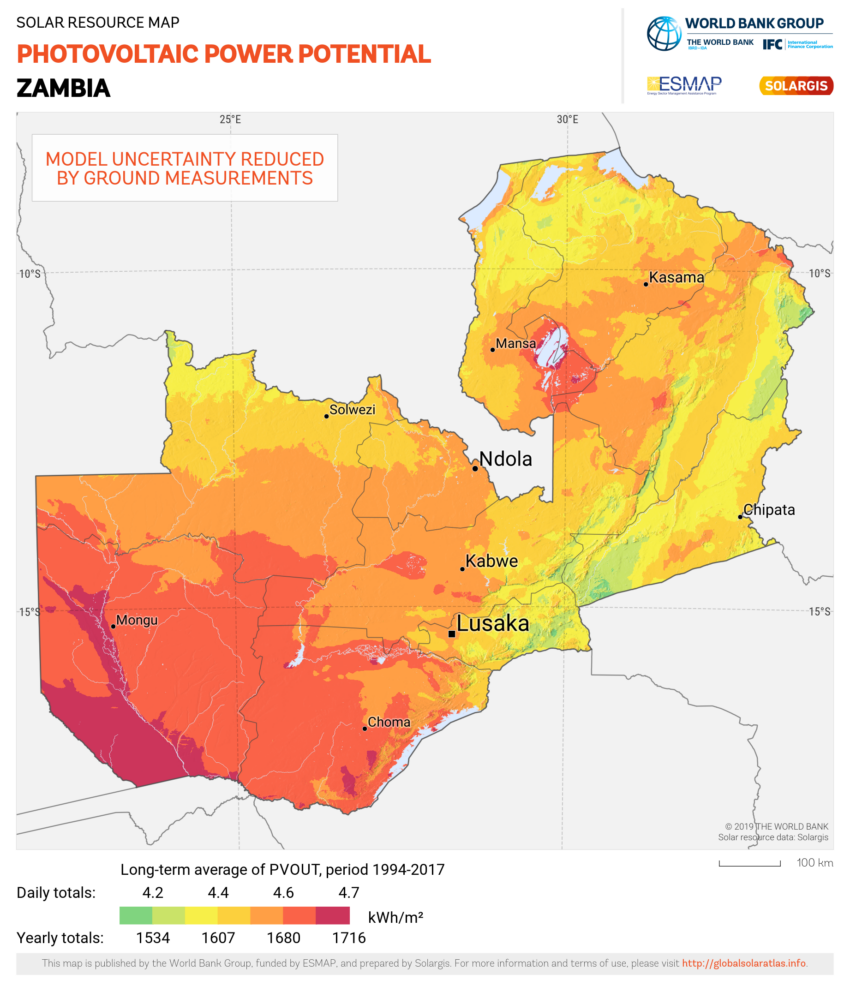
Net Metering
Net metering is a utility billing mechanism that allows residential and commercial customers who generate their own electricity to receive credit for the net power they contribute back to the electricity grid. Utilities will typically offer a tariff for what the customer sells back to the grid that may incentivise more take-up of self-generation. Net metering helps promote the adoption of renewable energy sources like solar power by making it economically beneficial for individuals and businesses to invest in solar panels and reduce their reliance on traditional electricity generation methods. It also reduces the need for costly battery storage solutions.
Draft net metering regulations were issued in Zambia in August 2022 by the Energy Regulation Board (ERB). This was followed by a consultative process calling for electricity supply stakeholders and the public to scrutinise the draft regulations and submit proposed amendments and comments in September 2022. In over a year since then there has been little progress publicly visible on net metering by the main state stakeholder institutions (ERB, ZESCO and the Ministry of Energy).
This has occurred during a time in which the legacy hydropower electricity generation methods have continued to suffer from the ill-effects of climate change leading to a brief period of load shedding in January 2023. With the El Nino climate pattern predicted for the 2023-2024 rainy season there has been an even greater imperative to quickly diversify electricity generation in Zambia away from its high reliance on hydropower.
Net metering represents a novel operational concept that poses a challenge to many utilities and national grid operators. It disrupts the conventional model of stable electricity markets that relied on fixed generation sources in consistent quantities. The integration of rooftop solar into a national grid reduces the market and profitability of historical generators and distributors of electricity. It shifts the balance of generation from utilities to the customer which may make monopolistic state-utilities less keen to support its adoption. The setting of the net metering tariff would be a complex balancing act that needs to meet the needs of existing non-solar customers, new solar customers, other electricity generators, grid operators, solar equipment vendors and the environment.
Duck Curve
Increased solar power generation attached to the grid introduces more variability compared to conventional baseload sources like hydropower. This variability is evident in the creation of the “duck curve” (resembling the silhouette of a duck) of grid electricity power demand, resulting from abundant solar generation during daylight hours, followed by a rapid decline in generation as the day ends. Addressing this shift requires the development of innovative supply and demand management techniques to ensure grid stability, especially as peak electricity demand occurs just after sunset.
One of the key components required to stabilise the grid with significant solar penetration is a battery or other energy storage system that can be quickly deployed as the sun sets. The Zambian electricity grid has ready-made energy storage infrastructure at Kariba Dam. Kariba Dam typically stores approximately 5750 GWh of electrical energy or about 30% of Zambia’s annual generation of 19,400 GWh in 2022. Displacing some of the use of hydropower generated at Kariba Dam with distributed rooftop solar during the day and reserving hydropower water for the evening peak would increase overall generation capacity. This is illustrated in the three plots below.
The first plot shows the modelled baseline demand and power generation mix for an average day in 2022 based on data from the ERB 2022 Energy Sector Report [2].
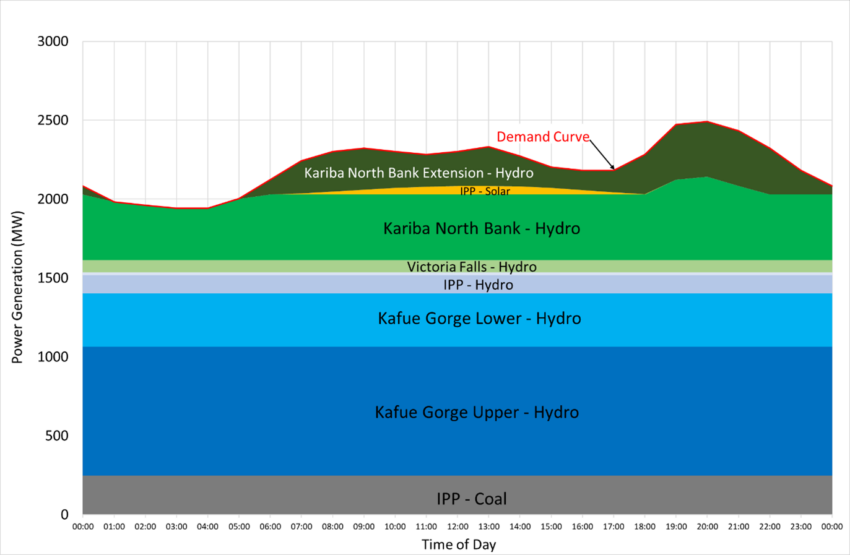
The introduction of 389 GWh of rooftop solar electricity annually, equivalent to 2% of total annual electricity generation, with a peak power of 150 MW, is shown modelled in the plot below. This indicates that the rooftop solar power could largely displace power produced at Kariba North Bank Extension (KNBE) during the morning and afternoon peak.
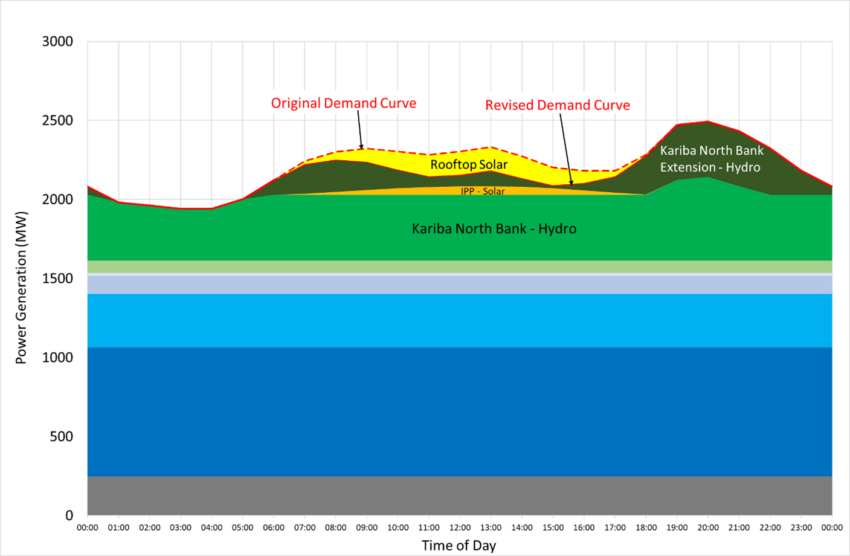
Further increases of rooftop solar to 5% of total annual electricity generation, 972 GWh with peak power 370 MW, as modelled below could further displace generation at KNBE but also require reduced production at the main Kariba North Bank (KNB) power plant. Managing such a variable output from KNB and KNBE would require innovative techniques of grid stability operation. This would be needed throughout the day as well as at sunset when generation at both stations would have to be ramped up to compensate for the loss of significant amounts of solar generation.
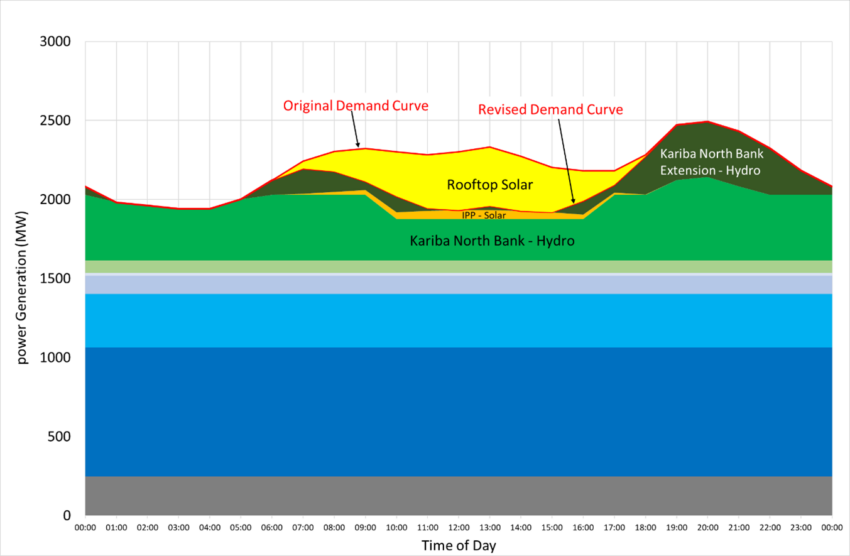
Smart Grid
The technology required to create a grid responsive to the new dynamics caused by increased generation variability would invariably increase costs for grid operators. However, with rooftop solar, this could be offset financially by increasing power generation without having to invest in large scale grid upgrades. It would also be the advent of a smart grid which is a necessary innovation from a technological advancement point of view.
A smart grid relies on various equipment and technologies to enhance the efficiency and reliability of electrical power distribution. Key components include smart meters, communication networks, data management systems, analytics software, remote sensors and switches, demand response systems, energy storage, cybersecurity measures and grid management systems. Such equipment would enable real-time monitoring, data exchange, and efficient management of the grid, facilitating better integration of renewable energy, improved reliability, and allow demand-side participation. A cost-benefit analysis would be required to weigh these additional costs against the wider benefits of adoption of rooftop solar systems. This could start with small proof of concept tests to help understand and develop the technology.
A typical grid of the future may look like the image below with a mix of grid-scale generation and localised rooftop generation all managed by smart grid software and tools.
South Africa
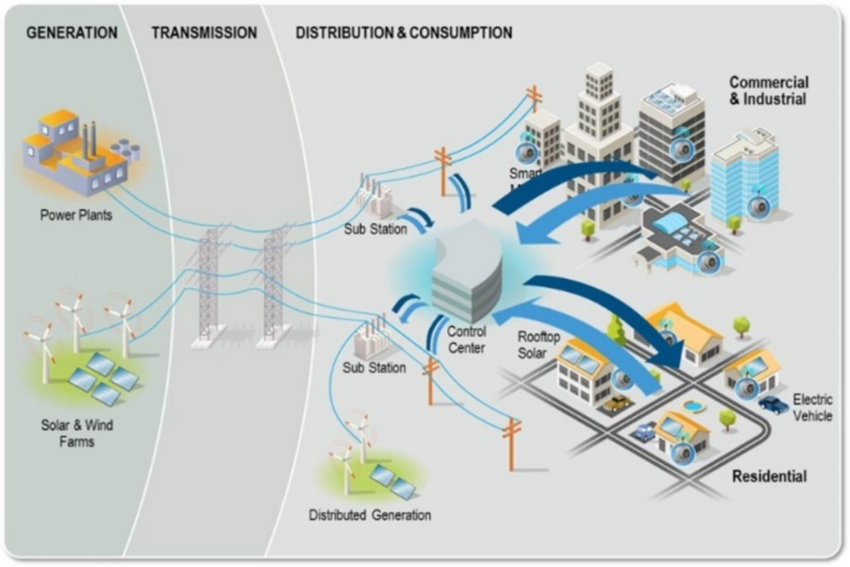
The South African electricity grid has been subjected to load shedding at various times since 2008. To counter this effect a recent surge in solar panel installations has occurred on the rooftops of houses and commercial and industrial buildings. In the 18 months to July 2023 a capacity of 3800 MW of solar panels has been installed. This is equal to 11% of peak power demand.

Vietnam
The rooftop solar capacity in Vietnam increased by a factor of 25 in 2020 going from 378 MW in December 2019 to 9.3 GW in December 2020. This was encouraged by policy incentives including a net metering tariff of USD 0.084 per kWh of electricity sold back to the grid (on par with other solar generation) and power purchasing contracts of 20 years duration. This expansion of solar power generation also helped create a solar panel manufacturing industry in Vietnam.
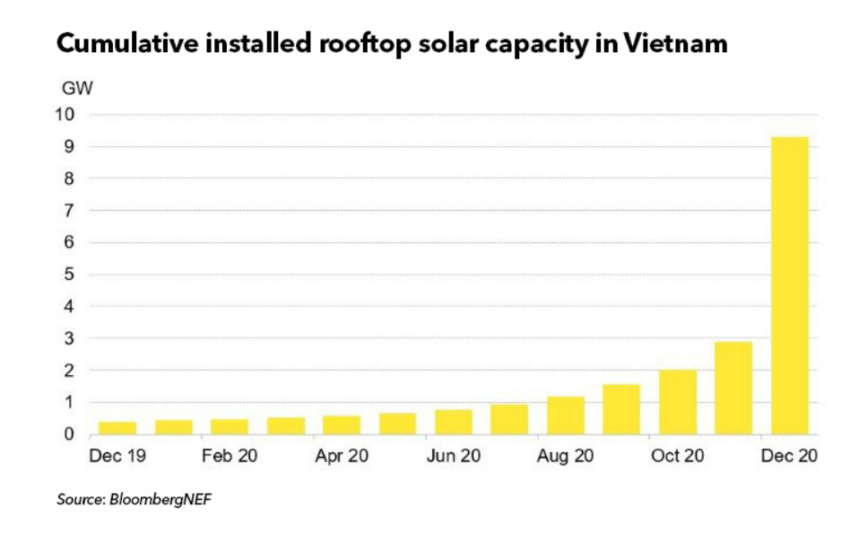
Australia has one of the highest per capita installations of solar capacity at over 1 kW per person. Most of this solar capacity is rooftop solar. The growth of rooftop solar uptake has been driven by natural advantages (plenty of sunshine) and progressive policy measures. Net metering tariffs and capital cost rebates for solar systems have helped. In addition, a light touch regulatory system has made it simple to install rooftop solar systems. The record of 39% of Australia’s national electricity power supply being provided by rooftop solar was achieved in September 2023 and is shown in the chart below.

Net metering is a compelling incentive for consumers to adopt solar power systems, enabling them to generate electricity for own use. The added benefit of selling excess electricity back to the grid significantly bolsters the financial case for investing in distributed solar power, mitigating the need for costly battery storage that could otherwise double capital expenditures. The substantial impact of rooftop solar on a nation’s total electricity generation capacity has been proven in countries that have incentivised this approach for customers. To rapidly expand Zambia’s electricity generation capacity, the energy sector must proactively embrace the future of rooftop solar generation and net metering integrated with cutting-edge smart grid technology.
References
- https://globalsolaratlas.info/download/zambia
- https://www.erb.org.zm/wp-content/uploads/files/esr2022.pdf
- https://media.licdn.com/dms/image/C5112AQHN3TsQ1RdHiQ/article-cover_image-shrink_600_2000/0/1567685117573?e=1701302400&v=beta&t=4tOFXiOta8RmzFsx5-wh94L1L_jtpU5rjwjkpafDI0E
- https://www.bloomberg.com/opinion/articles/2023-08-22/clean-energy-the-ups-and-downs-of-transition-in-south-africa?embedded-checkout=true
- https://about.bnef.com/blog/vietnam-was-likely-the-third-largest-solar-market-in-2020/
- https://aemo.com.au/energy-systems/electricity/national-electricity-market-nem/data-nem/data-dashboard-nem
Dr Roy Moobola is a specialist in energy solutions and a university lecturer in engineering.


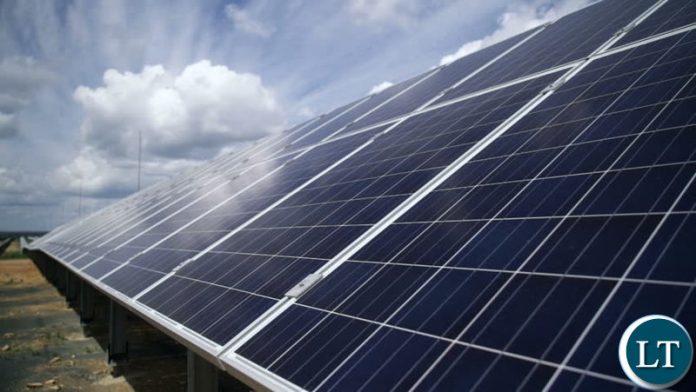
TLDR.
In terms of household lighting and small power consumption appliances like phones and radio receivers, the Chinese have solved that problem as you’ll notice the presence of their products in remote areas. However, many peasant consumers lose money as the quality of these products isn’t good. They’re being robbed as they require to replace these products frequently. The solar panels that Alcatel installed for the then Zambia Broadcasting Services between 1972 and 1976 are still working, but why do Chinese products have to be replaced every year? The Zambia Compulsory Standards Agency has failed the people on this one
Very well researched and written report.
As for why do Chinese’s rubbish only work a year or so , is that if all solar produces lasted like the ZNBC solar panels then no money would be made by the factories, the Chinese make things work for a certain time limit. Good example is the light globe it even states 2200 hours on the box or globe. companies want us to buy from them again evert couple of years not wait fifty years.
What is “photovoltaic power potential”?
Great article.
Kafue Gorge lower only operates as a peaking station for 3 1/2 per day as opposed to providing a base load through out the day.. In figures 2 and 3 , it only affects the demand curve during the peak hours.
Side note:
As you can see this article is beyond the comprehension of typical PF cadres. You wont see their comments unless you talk about low level issues like mealie meal prices.
Thank you for this insight. I will take it into consideration in future modelling.
Comments are closed.